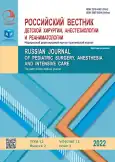Objectification of the treatment choice in children with isolated abdominal trauma, ruptured spleen
- 作者: Anastasov A.G.1, Zubrilova E.G.2
-
隶属关系:
- M. Gorky Donetsk National Medical University
- Republican Сhild’s Сlinical Hospital
- 期: 卷 12, 编号 2 (2022)
- 页面: 157-166
- 栏目: Original Study Articles
- URL: https://ogarev-online.ru/2219-4061/article/view/123577
- DOI: https://doi.org/10.17816/psaic1225
- ID: 123577
如何引用文章
全文:
详细
BACKGROUND: The risk of vital homeostasis disorders and the likelihood of death in patients with spleen injury is determined by organ damage, acute intra-abdominal bleeding, and often hemorrhagic shock.
AIM: This study determines the validity of the clinical criteria for the syndrome of intra-abdominal bleeding, shock, and the argumentation of indications for surgical treatment in the first six hours from the moment of hospital admission in children with an isolated injury, rupture of the spleen.
MATERIALS AND METHODS: The study included 89 patients aged 6 to 12 years with spleen injuries treated at the Republican Children’s Clinical Hospital of the Donetsk People’s Republic from 2014 to 2021. The first subgroup included 61 (68.5%) patients treated conservatively, and the second subgroup comprised 28 (31.5%) operated patients (splenectomy) who initially underwent conservative therapy. Blood pressure and heart rate were controlled, and hemoglobin, hematocrit, erythrocyte, and leukocyte counts were determined. Abdominal echography was performed every three hours.
RESULTS: In assessing the severity of the condition, there were changes in peripheral hemodynamic parameters, such as arterial hypotension and hemoperitoneum with hemorheological disorders (posthemorrhagic anemia of I–II degree, a tendency to thrombocytopenia). In the first six hours from hospital admission, the most objective clinical and laboratory indicators of bleeding and the choice of treatment method were the value of the hemoperitoneum, the level of arterial pressure system, hematocrit, and hemoglobin. No decrease in blood pressure in patients below 100.0 mm Hg, blood hemoglobin of 95.0 g/l with a hemoperitoneum volume of less than 275.0 ml dictated the expediency of continuing conservative therapeutic measures. In cases of deterioration in the condition of patients due to ongoing bleeding with the ineffectiveness of intensive therapy, surgical intervention (laparotomy, splenectomy) is recommended to stop the bleeding.
CONCLUSIONS: In the first hours after injury, the most accurate predictor of the choice of treatment method is the volume of the hemoperitoneum (according to echography), associated with the impaired hemodynamic status of the patient, namely arterial hypotension, which affects choosing a conservative or surgical treatment option.
作者简介
Andriy Anastasov
M. Gorky Donetsk National Medical University
Email: a.g.anastasov@gmail.com
ORCID iD: 0000-0002-9347-6694
SPIN 代码: 4614-0586
Dr. Sci. (Med.), Associate Professor of the Department of Pediatric Surgery and Anesthesiology
, DonetskEkaterina Zubrilova
Republican Сhild’s Сlinical Hospital
编辑信件的主要联系方式.
Email: zubrilova95@mail.ru
ORCID iD: 0000-0003-4282-7914
SPIN 代码: 4746-1333
anesthesiologist-resuscitator of the Department of Intensive Care and Resuscitation general profile
, Donetsk参考
- Coccolini1 F, Montori G, Catena F, et al. Splenic trauma: WSES classification and guidelines for adult and pediatric patients. World J Emerg Surg. 2017;12:40. doi: 10.1186/s13017-017-0151-4
- Radh.ru [Internet]. Russian Association of Pediatric Surgeons. Injury of the spleen in children. Clinical guidelines. November 9, 2021. (In Russ.) Available from: https://www.radh.ru/biblioteka/klinicheskie-rekomendaczii/pub-2480326.html. Accessed: 12 Jan 2022.
- Dodgion CM, Gosain A, Rogers A, et al. National trends in pediatric blunt spleen and liver injury management and potential benefits of an abbreviated bed rest protocol. J Pediatr Surg. 2014;49(6):1004–1008; discussion 8. doi: 10.1016/j.jpedsurg.2014.01.041
- Gaines BA. Intra-abdominal solid organ injury in children: diagnosis and treatment. J Trauma. 2009;67(2 Suppl):S135–S139. doi: 10.1097/TA.0b013e3181adc17a
- Grootenhaar M, Lamers D, Ulzen KK, et al. The management and outcome of paediatric splenic injuries in the Netherlands. World J Emerg Surg. 2021;16(1):8. doi: 10.1186/s13017-021-00353-4.
- Yunusov D.I., Mironov P.I., Aleksandrovich Yu.S., Pshenisnov K.V. Prognostic value of scales of combined injury severity scales for children. Russia Journal of Pediatric Surgery. 2017;21(4):207–210 (In Russ.) doi: 10.18821/1560-9510-2017-21-4-207-210
- Seliverstov PA, Shapkin YG. Assessment of Severity and Prognosis of Polytrauma Outcome: the Current State of the Problem (Review). Modern Technologies in Medicine. 2017;9(2):207–218. (In Russ.) doi: 10.17691/stm2017.9.2.25
- Bruijns SR, Guly HR, Bouamra O, et al. The value of traditional vital signs, shock index, and age-based markers in predicting trauma mortality. J Trauma Acute Care Surg. 2013;74(6):1432–1437. doi: 10.1097/TA.0b013e31829246c7
- Ott R, Krämer R, Martus P, et al. Prognostic value of trauma scores in pediatric patients with multiple injuries. J Trauma. 2000;49(4):729–736. doi: 10.1097/00005373-200010000-00023
- Nordin A, Coleman A, Shi J, et al. Validation of the age-adjusted shock index using pediatric trauma quality improvement program data. J Pediatric Surg. 2018;53(1):130–135. doi: 10.1016/j.jpedsurg.2017.10.023
- Karadeniz Cerit K, Ergelen R, Abdullayev T, et al. The effectiveness of non-operative treatment in high-grade liver and spleen injury in children. Ulus Travma Acil Cerrahi Derg. 2018;24(6):569-574. doi: 10.5505/tjtes.2018.83573
- Grigor’ev EV, Lebedinskiy KM, Schegolev AV, et al. Resuscitation and intensive care in acute massive blood loss in adults (clinical guidelines). Russian Journal of Anaesthesiology and Reanimatology. 2020;(1):5–24. (In Russ.) doi: 10.17116/anaesthesiology20200115
- Safarov ZF, Khakimov DP, Akhmataliyeva M.A., Alimov AA. Diagnostic significance of the Algover index for early recognition of shock in children. Problems of modern science and education. 2019;(5(138)):78–84. (In Russ.).
- Tepas JJ III, Mollitt DL, Talbert JL, Bryant M. The pediatric trauma score as a predictor of injury severity in the injured child. J Pediatr Surg. 1987;22(1):14–18. doi: 10.1016/s0022-3468(87)80006-4.
- Roden-Foreman JW, Rapier NR, Foreman ML, et al. Rethinking the definition of major trauma: The need for trauma intervention outperforms Injury Severity Score and Revised Trauma Score in 38 adult and pediatric trauma centers. J Trauma Acute Care Surg. 2019;87(3):658-665. doi: 10.1097/TA.0000000000002402
- Kozar RA, Crandall M, Shanmuganathan K, et al.; AAST Patient Assessment Committee. Organ injury scaling 2018 update: Spleen, liver, and kidney. J Trauma Acute Care Surg. 2018;85(6):1119-1122. doi: 10.1097/TA.0000000000002058. Erratum in: J Trauma Acute Care Surg. 2019;87(2):512.
- Galvagno SM Jr, Nahmias JT, Young DA. Advanced Trauma Life Support® Update 2019: Management and Applications for Adults and Special Populations. Anesthesiol Clin. 2019;37(1):13-32. doi: 10.1016/j.anclin.2018.09.009.
- Anastasov A.G., Shcherbinin A.V. Systemic inflammatory response syndrome and organ dysfunction in children with abdominal trauma. Pediatric Surgery. (In Russ.) 2020;24(2):128–133. doi: 10.18821/1560-9510-2020-24-2-128-133
补充文件






